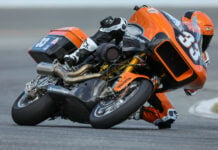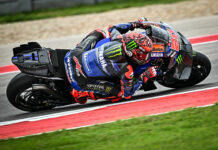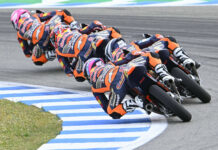The Dainese inflatable motorcycle road racing suit more than a decade in the making was unveiled for the U.S. market on Monday evening, marking a major milestone for the Italian safety gear manufacturer.
“This is major for us,” said Roberto Sadowsky, vice president of operations for Dainese USA Inc., at the introduction of the protection system at the D-Store in Costa Mesa, California. “We are not Toyota or Honda. We are “¦ an apparel company. This is very big for us.”
Indeed, the D-Air represents a new approach to safety gear for motorcycle road racing. Active rather than passive, anticipatory rather than reactive, the D-Air literally relies on space-age information processing technology to know when the rider will need help and deliver it.
The suit is not cheap, starting at $3,995, and is to be used for closed-course competition only. But the payoff is this: The upper limit of acceptable force transmission for shoulder, elbow, forearm and knee armor under the European CE standard 1621-1 is 35 kilonewtons (kN). Most traditional body armor transmits 23-24 kN under the CE test procedure, Dainese says.
The D-Air transmits 3 kN of force under the same impact, Dainese says.
The mechanics of the airbag system are the relatively easy part. A mechanically-triggered chemical reaction floods the air bag chambers inside the leathers (protected from abrasion) around the neck, collarbones and shoulders with four liters of gas. The reaction is considered “cold” the reaction is not an explosion, Dainese says.
The system activates within 15 milliseconds of a triggering event, deploys the bag within 30 milliseconds and has it fully inflated within 80 milliseconds. A video by Dainese illustrates the speed with which the system inflates; in the high-speed video, a rider stands still while the bag is inflated. In the video, the rider appears to slowly close his eyes and hold them closed. But the video is dramatically slowed to show the chambers inflating; what appears to be a rider slowly closing his eyes and keeping them closed is, in real-time, literally a blink of the rider’s eyes.
The system is designed to inflate once, and then slowly de-inflate. The system will not operate again until it is re-charged; but until then (for example, if a rider re-mounts after a triggering crash and continues racing) the rider is protected by a traditional top-of-the-line Dainese suit with all of the traditional body armor in place.
The really hard part of an inflatable air bag system is getting it to deploy when needed and to not deploy when it isn’t. This is a remarkably tricky thing to get right in the world of motorcycle road racing, where racers often have their bikes heeled over to the point where their elbows are on the ground and the front, rear or both wheels are sliding. To mortal riders, it’s a crash; to a MotoGP rider, it’s just another method of shaving a couple of thousandths of a second in a high-speed bend.
Dainese decided against a tether cable because in the event of a crash where the rider does not leave the motorcycle, the system will not be activated. In fact, the system Dainese ultimately chose does not rely on any information from the motorcycle at all, and does not connect to the motorcycle in any way.
To put it simply, over the past dozen years, Dainese has been gathering motion data from motorcycle road racers and analyzing it along with its technical partners the University of Padua’s Dynamotion unit, 2D Data Recording Systems in Germany and iSi Automotive in Vienna. 2D does data applications for Motorsports of all types, including road racing motorcycles; iSi makes airbags for automotive applications.
Dainese knows what motions and forces are generated by a rider doing what a racer does going fast and knows what motions and forces are generated by a crashing rider. That stack of data also allows Dainese and its technical partners to know the difference between those two situations a difference that can be so subtle that a rider can be crashing and not know it. That massive stack of data allows the suit’s programmers to be able to tell the suit when a crash is occurring and to trigger when the rider experiences that specific, highly-defined set of forces and motions.
Now all that is left is to get the suit to know when the rider is experiencing those forces and motions. That is left to an electronic brain inside the hump of the suit that includes a global positioning sensor, a two-gigabyte internal memory, three accelerometers and three gyroscopes, all powered by a lithium polymer battery. The “brain” is constantly comparing the GPS and internal motion data to the stack of data stored in its memory. Something looks like it’s going bad, and the suit inflates up to two bars of atmospheric pressure slightly more than 29 psi.
Unlike some early systems, the suit is designed so that when it inflates, the rider’s ability to control the motorcycle is not impaired. The entire system weighs 650 grams, or less than a pound and a half.
Dainese knows that it could not bring a half-baked system to the market, or it would poison the well for companies (including itself) that would try to market similar airbags in the future. So the company says it has tested and tested the system for every conceivable pitfall. The company says the system does not interfere with other electromagnetic devices and is not affected by them; is electrically insulated from the rider; has survived brutal testing in heat, cold, and thermal cycles; vibration and impact tests, aging tests, salt spay testing and dust stream testing. All chemicals meet existing safety standards. So does the battery. Inflation doesn’t whip the rider’s head around. Even the noise of inflation meets acoustic safety standards (because, you know, you wouldn’t want to not be able to hear your MotoGP bike!)
Dainese says the system even knows when the crash isn’t violent enough to warrant the inflation of the airbag system. In less-severe crash dynamics, the “brain” can delay the triggering mechanism. The bag won’t deploy in crashes under 50 kph (about 31 miles an hour).
A rider who purchases the suit can also purchase a $220, two-year maintenance package that will allow them to send a crashed suit back to Dainese at the company’s cost to replace the gas generator and airbag. The package also offers the rider discounts on repairs, cleaning and shipping.
When asked about the differences between this system and the system worn by Valentino Rossi, Sadowsky replied, “There are none. It is the exact same system.”
Yoshimura Suzuki’s Blake Young was on hand for the introduction, and was presented with his new D-Air suit at the event. Young, a 10-time AMA Pro Racing National Guard American Superbike winner, said just knowing he was wearing the latest and best from Dainese made a difference in his mindset when racing in the last 2011 event a barn-burner of a race weekend at New Jersey Motorsports Park.
“To know, in the back of your mind, that the protection is going to be there when you need it is, for us, motorcycle racers, one less thing on your mind,” Young said.
More, from a press release issued by Dainese:
Dainese introduces D-air Racing in the USA
(Costa Mesa, CA). A crowd of journalists gathered at the D-Store Orange County for the 2012 Dainese and AGV collections preview. After ten years of reserach and development, the Italian manufacturer presented the D-air Racing suit: the First of its kind to be sold in the US.
This highly-anticipated Dainese D-air Racing suit will be available for purchase in the USA. This hightech suit operates as a protection device as well as an impressive track day tool. Developed on race racetracks with the help of top Dainese racers including Valentino Rossi, Stefan Bradl, Leon Haslam and Max Biaggi, the D-air Racing works in synergy with existing armour in race suits and gives airbag protection to shoulders and improves protection in the neck and upper chest area.
The electronic system identifies a fall or slide and immediately sends a trigger signal to the gas generator in the hump of the suit. This activates the internal airbag, which then inflates within 30 millieseconds. D-air Racing has a patented 3D airbag structure providing the rider with a controlled airbag expansion. It is the only airbag suit on the market that works wirelessly without any connection to a motorcycle.
Aside from the unique safety features, the D-air Racing suit is a track day enthusiast’s ideal tool for improvement. The system features data acquisition software developed by German company 2D (2d-datarecording), which supplies some of the top teams in MotoGP and F1. The software gives D-air users an effective source to monitor riding performance and record telemetry data, that can be downloaded and displayed on a computer. Extensive functions of the system include lap time data, GPS telemetry of the bike and diagrams in relation to time: assessment of braking spaces and lines through bends. Acceleration data is also available and the system is compatible with Google Earth and enables plotting of racing lines on a mini map. The D-air Racing system passed all motorcycle personal protective equipment tests, not only for the current European standards but also for pre-standards, which will come into effect in the future. The D-air system is so innovative that the current standards were only partially able to meet the certification needs of an advanced system. TÃœV SÃœD were required to develop a new and more appropriate testing producer before submitting the D-air Racing system, which went far beyond the existing standards. D-air Racing is proud to be TÃœV SÃœD system certified.
During the presentation, Dainese delivered the first D-air Racing suit to Blake Young, AMA Superbike racer. He will be the First US rider to use the suit in the AMA Superbike Championship.
The suit can be custom made by size, colors, names and logos. The suit will be available for ordering starting from June 2012, with a starting cost of $3,999. For more information please contact your authorized Dainese dealer. For a complete list of dealers D-air Racing certificated please stay tuned on Dainese.com.





